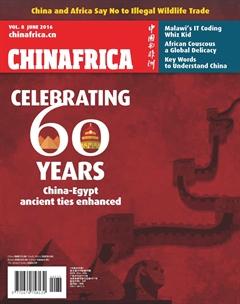Art for Heart’s Sake
By Rachel Richez
Once Manshiyat nasr, a ward in cairo, used to be one of the poorest areas in the Egyptian capital. It was known as “garbage city” because of its large community of rag-pickers.
But in March, after eL Seed waved his magic wand over it, it became celebrated for its unusual art. Perception, the mural created by the French-Tunisian artist and his team on over 50 buildings, which required the use of scaffoldings and safety harnesses, is not just art. It is a tribute to the rag-pickers community which does a yeomans job to keep the city clean and yet is stigmatized and marginalized because of what they do.
Back to roots
Seed, born in France to Tunisian parents and now based in Montreal, Canada, says he felt the need to reconnect with his African identity in his teen years. He then discovered Arabic calligraphy, which became the inspiration for his art. Mixing this traditional art with modern street art, he has created a new style, known as calligraffiti.
“Triggered by an identity crisis, my artistic approach developed to become a modest tool uniting people and cultures,” he said. He uses the intricate and colorful Arabic calligraphy on walls or buildings to create art that can be appreciated even by those who cannot read Arabic. The 34-year-olds first large-scale mural in Kairouan, a city in Tunisia, is a calligraphic representation of a Tunisian poem honoring people who fought against tyranny.
For Perception, he conceived an impressive 300-meter-diameter circle in white, orange and blue, which can be fully viewed only from the Muqattam Mountain, a mountain range in southeast Cairo. The lines quote St. Athanasius of Alexandria, a third-century bishop from the Coptic community, an ethno-religious group following Christianity: “Anyone who wants to see the sunlight clearly needs to wipe his eyes first.” The garbage collectors of Cairo, known as zabbaleen - the garbage people -are also Copts.
Seed told ChinAfrica he wanted to question the perception people have of the community. They are people who have been collecting the waste of Cairo by hand for decades, and have developed a very efficient recycling system. But despite the obvious contribution of the community, they are segregated and looked down upon as people who follow an unclean livelihood.
“I wanted to honor Manshiyat Nasrs community,” Seed said. “I [also] wanted to open a conversation about how we judge our fellow humans, about the importance and responsibility of every one of us in society. The garbage peoples neighborhood in Cairo is only an excuse to open a conversation about perception.[It is] about how our preconceived ideas on a community make us judge them, and condemn them even if we dont know them.”
At night, the fluorescent white paint in the mural becomes illuminated, casting a mystic light on the work. By shedding light on the Manshiyat Nasr neighborhood, Seed wants to promote tolerance and respect. His message is not only addressed to Egypt, but to the world. It seems to be a common thread in his work. In 2012, he called for unity and understanding by painting a 47-meter mural on a mosque in the southern Tunisian city of Gabès. The Jara Mosque painting quotes from the Koran: “Oh humankind, we have created you from a male and a female and made people and tribes so you may know each other.”
African inspiration
Seed continues to spread his message with exhibitions and murals around the world: Algeria, Qatar, Canada, France, Italy, Germany, Australia, the United Arab Emirates and more. “Every piece I create has its own political, economic and social context. For me, its very important that a piece in South Africa or in Tunisia is different from a piece in France or in Greece. The piece becomes the propriety of the community. I completely detach myself from it once its done.”
Wherever he goes, people welcome him warmly and generously, even when they dont have much. His work requires proximity with the locals. Besides knowing about the place socially and culturally, he also selects locals to work on his massive projects with him. And what he experiences while interacting with the communities motivates him to continue.
He calls Africa “a source of inspiration.” “The reception and the human warmth are very special,” Seed said, narrating his experiences on the continent. “In Algeria, when I was painting the seventh floor of a building, a woman opened her window [from an apartment on the story] and asked me if I had breakfast. I said I was going to eat later. She gave me a plate of hot couscous that she had specially prepared for me.”
In Cape Town in South Africa, he says the people of Philippi Town allowed him to paint on their only brick wall, which belonged to a primary school. “Tens of children helped me put the colors,” he said. The mural quotes Nelson Mandela: “It always seems impossible until its done.”

